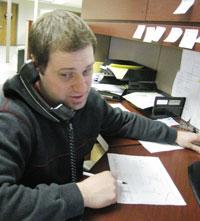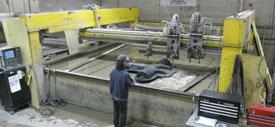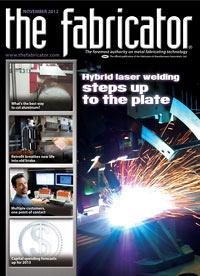Senior Editor
- FMA
- The Fabricator
- FABTECH
- Canadian Metalworking
Categories
- Additive Manufacturing
- Aluminum Welding
- Arc Welding
- Assembly and Joining
- Automation and Robotics
- Bending and Forming
- Consumables
- Cutting and Weld Prep
- Electric Vehicles
- En Español
- Finishing
- Hydroforming
- Laser Cutting
- Laser Welding
- Machining
- Manufacturing Software
- Materials Handling
- Metals/Materials
- Oxyfuel Cutting
- Plasma Cutting
- Power Tools
- Punching and Other Holemaking
- Roll Forming
- Safety
- Sawing
- Shearing
- Shop Management
- Testing and Measuring
- Tube and Pipe Fabrication
- Tube and Pipe Production
- Waterjet Cutting
Industry Directory
Webcasts
Podcasts
FAB 40
Advertise
Subscribe
Account Login
Search
Sales strategy drives growth at Minnesota Fabricator
How a waterjet job shop services diverse customer base
- By Tim Heston
- November 9, 2012
- Article
- Waterjet Cutting

Figure 1: Kris Cabak confirms an order with a customer. Fedtech’s salespeople shepherd orders through multiple front-office operations. They act as the single point of contact for customers.
Most fabricators recall 2009 with a sigh. They talk of sales plummeting by 30, 40, sometimes more than 50 percent; the ensuing layoffs; the hard choices; the hard times. But not Fedtech.
“In 2009 we had a record year.”
So said John Bobrowski. The sales manager at the St. Paul, Minn., fabricator said that the company may set another sales record this year. Revenue hit $13 million in 2011, and managers expect 2012 earnings to reach $15 million.
He attributed the fabricator’s success to several factors. The company has an unusual technology mix, with 11 abrasive waterjet machines that cut everything from plastic to thick metal plate. Complementing these are several CNC milling and turning centers for tight-tolerance work, as well as two laser cutting systems, press brakes, welding, and assembly. The shop can handle a variety of jobs of various tolerances, and it often uses several cutting technologies to meet product specifications. For instance, the abrasive waterjet may cut an edge, but a mill may machine a precision hole.
The company performs work for many sectors, from the architectural field to medical and defense industries, and no one customer makes up more than 10 percent of overall revenue. While the defense industry kept the company growing throughout the financial crisis, the sector now makes up a smaller portion of overall revenue. Various other sectors, including medical and aerospace, continue to drive growth.
Fedtech has more than 350 active customers that salespeople work with at least every month. They provide the shop with between 12,000 and 14,000 jobs a year. Most are very short-run, nonrepeat orders. Jobs flow from the primary cutting centers, and many require bending, welding, as well as kitting and assembly. This is a high-mix, low-volume operation at its purest.
“We’ve got a very large, diverse customer base,” Bobrowski said. “We don’t have, say, 85 percent of our work coming from one customer. We have had a few customers that have provided up to 10 to 15 percent of revenue for a given year, but we don’t have that anymore, simply because of how Fedtech has grown.”
In one sense, these stats sound ideal. The diversity protects the shop from downturns, and such diversity certainly isn’t the norm. About a quarter of the respondents to the 2012 Financial Ratios & Operational Benchmarking Survey, a study conducted by the Fabricators & Manufacturers Association, said that five or fewer customers brought in 80 percent of company revenue. This makes Fedtech’s business—with hundreds of active customers from various industries—seem rock-solid.
But there’s a downside to this. Managing a shop full of a great number of incredibly diverse short-run, nonrepeat orders can be a complicated undertaking. At Fedtech, repeat orders represent only 10 to 12 percent of the jobs on the floor.
So how does the shop manage it? Bobrowski put it this way: “It’s about giving customers a single point of contact. It’s a cradle-to-grave concept. Upon receipt of orders, that person helps facilitate the ordering through the production. That person remains the customer’s single point of contact for the life of the project.”

Figure 2: Sales personnel work closely with various front-office personnel, including Programmer Chris George (pictured), to shepherd jobs from order entry through production.
Job Shepherds
Bobrowski was the shop’s second salesperson hired after Dave Fox launched Fedtech as a waterjet job shop in 1996. Today seven people, including Fox and Bobrowski, lead Fedtech’s sales efforts. With 73 employees total, the company’s salespeople make up a tenth of the overall workforce. The salespeople do more than just sell, though. They estimate, work with engineering and programming personnel, and communicate with production to fit the job into the schedule (see Figures 1 and 2). In a sense, they’re job shepherds. They ensure no work order goes astray.
As Bobrowski explained, several critical elements make this strategy work well. First, salespeople don’t cover geographic territories. Instead, they focus on industries. This is roughly analogous to giving a specific beat to a newspaper reporter. Like most fabricators, Fedtech serves a horizontal market, one that feeds various vertical supply chains, from aerospace to power generation. Each salesperson becomes an expert in specific industries, which in turn helps him better relate to customers.
If salespeople had geographic territories, they wouldn’t become such industry experts, and they would have a tough time shepherding various types of jobs through the front office to the shop floor. One job may be for an aerospace company that demands extremely tight-tolerance work; the next customer might be a metal artist with a napkin sketch.
These market divisions aren’t etched in stone. Becoming an expert in certain industries is great, but a salesperson may have trouble providing adequate service if he has too many customers. That’s why managers are careful not to overload any one salesperson. At this writing, for instance, many new customers that come onboard are being handled by Fedtech’s newest salesperson, who was brought on earlier this year.
The number of accounts a salesperson has isn’t as important as the value and work that go into those accounts. For instance, one salesperson dedicated to the defense industry works with just three large customers. “Another salesperson we have works with about 150 customers, and many of them may not do more than $100,000 worth of work with us a year,” Bobrowski said. “They’re all small but very important customers to us.”
Another critical element is the salesperson’s technical expertise. Almost every salesperson at Fedtech started in technical positions on the shop floor, so they know the capabilities of turning versus milling versus waterjet cutting versus laser cutting. The one salesperson hired on from another company spent six months on the shop floor learning the intricacies of metal fabrication.
Salespeople may not be absolute technical gurus, but they know enough to ask the gurus on the floor about manufacturing alternatives. Bobrowski recalled one job that kept increasing in price with every drawing revision. During the customer service process, though, the salesperson asked the CNC turning center operator about fixturing alternatives. It turned out that a slight design change made fixturing much easier and eliminated two turning operations. The change brought the quote back down nearly to the original price.
How Service Drives Technology Adoption
Such sales focus led to the machine technology mix on the floor. “We added lasers after several of our largest customers repeatedly asked us if we could offer laser cutting services,” Bobrowski said. “They were buying waterjet from one place and laser cutting from another place. The same thing happened with our machining capabilities. People had waterjet-cut parts that required additional tapping, milling, or turning. All of our capacity and current capabilities were built up because of customer demand. It came about because they were satisfied with the services they were getting.”
What are these services exactly? It starts with the initial order and verification. “There are so many details that aren’t necessarily on prints,” Bobrowski said. “When you get into some of the defense and medical applications, yes, those details are on the prints. Those orders are very detailed, very black and white. But when you get into the [ornamental] architectural sector, like artwork for airports and jobs of that nature, a lot of verification is done over the phone, working with people to develop what they want. And we have the same person there to answer all the questions and then work with production, to make sure the customers get what they’re looking for.” This effectively eliminates any miscommunication between multiple people in the front office, because one person carries the job through multiple steps.
More Machines, Shorter Setups

Figure 3: Fedtech has 11 waterjet machines, and each is dedicated to specific kinds of jobs, depending on the material type and thickness, part geometry, and tolerances required.
With so many short-run, nonrepeat jobs, short setups are critical. A waterjet may have a “soft” tool that can cut any shape, but different materials can require specific substrates and fixturing.
This is why the shop has 11 machines of various brands (see Figure 3). Each machine can handle certain types of jobs, depending on material type and thickness, part geometry, and tolerances required. Changeout procedures are standardized at each machine. Some work centers are dedicated to certain part geometries; for instance, one waterjet has a rotary axis, so it receives a lot of 3-D cutting work. Another waterjet with no abrasive is dedicated to cutting plastics, urethanes, wood, and similar materials.
“This means we can run many jobs of a similar nature without having to completely re-set up the process,” Bobrowski said, adding that integral to the setup is the substrate supporting the material being cut. Substrates can vary from foam to plastic to extremely heavy, thick cross members. Certain substrates are planed off level, to ensure the work material is perfectly perpendicular to the waterjet—ideal for extremely tight-tolerance work. Ultimately, the substrate type depends on what’s being cut.
“There are quite a few cutting substrates that can be used on the watjerjet,” Bobrowski said. “If you’re cutting small, delicate parts, you’re putting them on foam. If we’re cutting 6-in.-thick steel, we use cross members that are 12 in. thick to hold it up. If you switch between foam and these heavy cross members from job to job, the setups would be prohibitively time-consuming.”
About Service
“Our competitive edge is customer service,” Bobrowski said. He added that, yes, it’s a marketing cliché, because every company on the planet says they have great customer service. But how do you define it?
At Fedtech, it’s about having one point of contact, a technical expert who knows the customer’s market and communicates continually to ensure every party in the transaction is on the same page. “It’s nothing fancy, really. We just take a step back and try to provide what’s often hard to get these days, with automated phone answering systems and outsourced customer service,” Bobrowski said. “We’re just the opposite.”
Most important, when salespeople talk with customers, they provide immediate, truthful answers. “Please hold, I’ll transfer you” isn’t in their vocabulary.
About the Author

Tim Heston
2135 Point Blvd
Elgin, IL 60123
815-381-1314
Tim Heston, The Fabricator's senior editor, has covered the metal fabrication industry since 1998, starting his career at the American Welding Society's Welding Journal. Since then he has covered the full range of metal fabrication processes, from stamping, bending, and cutting to grinding and polishing. He joined The Fabricator's staff in October 2007.
Related Companies
subscribe now

The Fabricator is North America's leading magazine for the metal forming and fabricating industry. The magazine delivers the news, technical articles, and case histories that enable fabricators to do their jobs more efficiently. The Fabricator has served the industry since 1970.
start your free subscription- Stay connected from anywhere

Easily access valuable industry resources now with full access to the digital edition of The Fabricator.

Easily access valuable industry resources now with full access to the digital edition of The Welder.

Easily access valuable industry resources now with full access to the digital edition of The Tube and Pipe Journal.
- Podcasting
- Podcast:
- The Fabricator Podcast
- Published:
- 04/16/2024
- Running Time:
- 63:29
In this episode of The Fabricator Podcast, Caleb Chamberlain, co-founder and CEO of OSH Cut, discusses his company’s...
- Trending Articles
AI, machine learning, and the future of metal fabrication

Employee ownership: The best way to ensure engagement

Dynamic Metal blossoms with each passing year

Steel industry reacts to Nucor’s new weekly published HRC price

Metal fabrication management: A guide for new supervisors

- Industry Events
16th Annual Safety Conference
- April 30 - May 1, 2024
- Elgin,
Pipe and Tube Conference
- May 21 - 22, 2024
- Omaha, NE
World-Class Roll Forming Workshop
- June 5 - 6, 2024
- Louisville, KY
Advanced Laser Application Workshop
- June 25 - 27, 2024
- Novi, MI


























